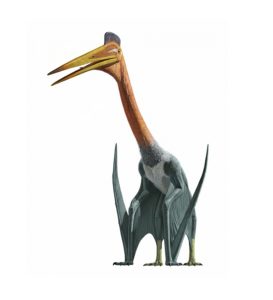Updated on: 28/03/2022
Pterosaur belongs to an extinct group of flying reptiles that lived about 228 to 66 million years ago. Even though many refer them as “flying dinosaurs,” it is a misconception because unlike dinosaurs, pterosaurs were not the descendants of the groups Ornithischia and Saurischia.
| Kingdom: | Animalia |
| Phylum: | Chordata |
| Class: | Repitila |
| Clade: | Ornithodira |
| Clade: | Pterosauromorpha |
| Order: | Pterosauria |
| Name Meaning: | Winged Lizard |
| Geological Period: | Late Triassic to the end of the Cretaceous period |
| Wingspan: | 16 feet to 43 feet |
| Weight: | 26 to 550lb |
| Location/Distribution: | America, South America, Europe, Asia |
| Diet: | Carnivore |
| Birth type (reproduction): | Eggs |
| Locomotion: | Wings |
Pterosaur is mainly divided into two major groups, namely rhamphorhynchoidea and pterodactyloidea. The rhamphorhynchoids were relatively small in size with broad wings, short necks, short robust skulls and very large wing membrane.
Pterodactyloids, on the other hand, were big in size with narrow wings, long skull (mostly no teeth), small rear wing, and a short tail. Crest bone was present in both the groups, but they were very big and intricate in pterodactyloids.
Some common genera of pterosaurs include
The initial discovery of this prehistoric reptile’s fossils was found preserved in Solnhofen limestone formation in Bavaria, Germany by an Italian naturalist named Cosimo Alessandro Collini in 1784. Initially, he assumed it as a sea creature, and this theory was supported by a German zoologist Johann Georg Wagler in 1830. However, in 1801, a French naturalist George Cuvier differed from both, and he suggested that it was a flying creature.
The name “pterodactyl” given earlier was scientifically incorrect. Today, paleontologists use the name “pterosaur” for all the members of the order “Pterosauria” whereas the term “pterodactyl” is restricted to the members of the genus Pterodactylus.
Pterosaurs were very light in weight because of their hollow and air filled skeleton bones, an adaptation that aided flight. The skull had extended jaws which appeared like a long beak with a full set of needle-like teeth. The feature that distinguished Pterosaurs was the crest on their head. Some of them had bony crest while others had fleshy with no underlying bones.
Pterosaurs’ wings were formed by the membranes of skin and other tissues, running between the shoulders and wrists. Some of them had a third membrane between their legs which was like an incorporated tail.
Some Pterosaur species lived nearby water while some were terrestrial. The terrestrial ones fed on carcasses, baby dinosaurs, lizards, eggs, insects and other animals. The marine pterosaurs ate fish, squid, crab and other shellfish.
Not much is known about their habitat. It is believed that they used to live in large flocks.
During the breeding season, the head crest played an important part in the mating competition or choosing a mate. The pterosaurs laid few eggs at a time and buried them in nests. They could lay up to 100 to 300 eggs in a life span and the eggs were somewhat soft like turtle eggs. The growth of pterosaur was very rapid, and they attained adulthood in a span of few years.
They were known to be great fliers. One of the theories suggests that they were cold-blooded gliding animals. The takeoff strategy still remains a bit unclear, but it is assumed that they used their hind legs to produce thrust for getting airborne.

In the later stage, Mark Witton from the University of Portsmouth and Mike Habib of Johns Hopkins University indicated that a vaulting mechanism was used by pterosaurs for taking off and the powerful winged forelimbs helped them to gain flight easily. Once airborne, they could attain a speed of about 120 kilometers per hour (75 mph) and can travel great distances at a stretch.
The exact reason behind pterosaur extinction is not known yet. There are several theories which describe the extinction of this winged reptile. One theory suggests that the Cretaceous-Palaeogene extinction event wiped out the pterosaurs along with other avian and non-avian dinosaurs.